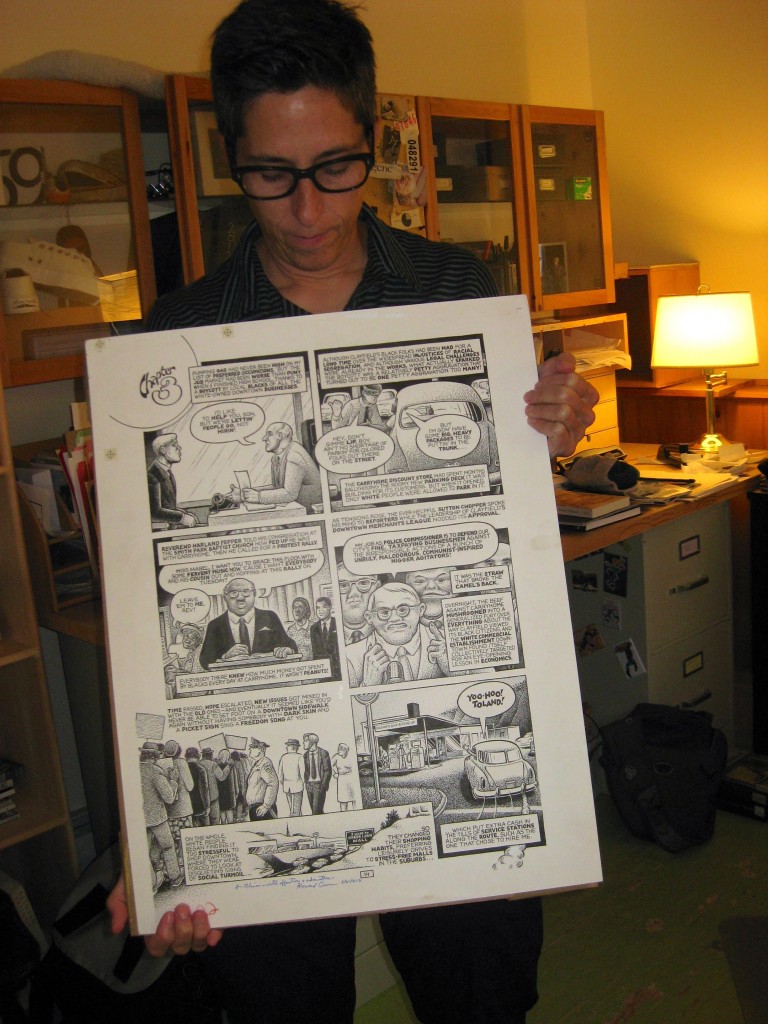Howard Cruse originals
September 30th, 2013 | Uncategorized
I just bought a page of original art from Howard Cruse’s epic graphic novel Stuck Rubber Baby. I got to see some of these pages way back in the early 90s when Howard was working on the book. But I’d forgotten how huge and amazing they are. Look at this thing!
I know it’s overlapping the sidebar, sorry, but I don’t want to run the image any smaller.
Anyhow, I’m just blown away to be in the presence of Howard’s incredible line work. He did this all with a freakin’ Rapidograph. And bear in mind, this is ONE of 210 other densely cross-hatched, beautifully designed, painstakingly hand-lettered pages. You should buy a page too! Go here! There’s art from his long-running strip Wendel, too, and it’s all on sale.


10 Responses to “Howard Cruse originals”
Rapidograph pens! Yes! The page of Howard’s artwork reminds me of album artwork vs. the reduced version on a CD. I miss the world of the tactile and tangible.
Meanwhile, I saw your face at the end of this insightful article. http://www.buzzfeed.com/alannaokun/hey-guys-who-only-read-other-guys-stop-that
I remember (a thousand years ago, in the late 70s, as a student of design) the deep pleasure I would get from bringing sundry old, neglected, clogged up Rotring Rapidographs back from the dead. I don’t think I lost one. There you have it; another craft skill no longer needed. >sigh>
BTW, for anyone who still happens to have a Rapidograph, keep drawing with it. They’re just like pearls; keeping them next to your skin and in use will keep them lovely and working.
Thanks Alison and Ellen for these memories!
Back during my days as a doctoral student (prior to personal computers and graphics programs), for my presentations at scientific meetings and ilustrations in journal articles I used a rapidograph to accurately trace out the convoluted squiggles on geophysical logs (like these logs showing the radioactivity of the Huron Shale – that’s why the gamma ray curve on the left jumps off-scale in the interval occupied by the Huron Shale). You had to get into a certain mind-set to accurately free-hand an accurate representation of the log. My father, who had trained as a commercial artist during the 1930’s, always seemed proud of me doing things like that.
[AB in this week’s NYTimes Book Review: [HERE]
(Click ahead to pg. 5) –Mentor]
Ok, ok. I used a light table*. Also, formations like the Huron Shale that are mainly compressed and compacted mud and silt contain most of the organic detritus that gets deposited with sediment. That organic matter tends to absorb uranium from groundwater, so shales show up dramatically on gamma ray logs (recordings of changes in radioactivity with depth in a well).
* Light tables are (were) little tables with a translucent panel over a bank of fluorescent lights. You could trace out things for your illustrations on it. But, hey, it still took a steady hand and nerves of steel! Honest!
I picked up a page from Howard several years ago (page 196). It is one of the treasures of my collection, one I will never part with. His work deserves much greater recognition!
What stands out to me, from a technical standpoint, is the stylistic departure of this book. To this point, Howard had been known for using stipple. But with SRB, he turned to a detailed and varied hatch for his gray values. Just as effective, but as a champion of stipple, I was a bit sad to not see it in this work.
The most recent comment in the post announcing the ticket contest is spam:
http://dykestowatchoutfor.com/fun-home-the-musical-ticket-contest#comment-320603
(Somebody has gone to the trouble of spamming random blogs to promote a Ukrainian florist. I didn’t realize the cost of link spam was THAT low.)
[Gone. –Mentor]
Also, if there were an “admin@dykestowatchoutfor” or “mentor@dykestowatchoutfor” (or similar) email address, I’d use that instead of posting an irrelevant comment.
Alison, I enjoyed your contribution to the Times. It makes me wonder: when you picked up Flying, did you remember your earlier encounter with Millett?
I used a Rapidograph and black ink to take all my notes in college back in the 70’s. Loved that pen.
I remember Alison saying how she’d learned from Howard Cruse about how bold outlines could strengthen her work.
Today my French-language “Fun Home” arrived from a bookstore in Rome, Italy. I’d had an AbeBooks request for it for years.
The cover is stunning: it features a silvery mirror in an ornate, scarlet, rectangular frame. A silhouette of the young child Alison looks at the mirror from the side. A solemn and beautiful portrait of her father shines back. That cover, with end-flaps, can be removed to reveal a more familiar portrait of the house with family members silhouetted in their solitary pursuits.
What a joy to see all the original hand-lettered text now beautifully hand-lettered in translation!